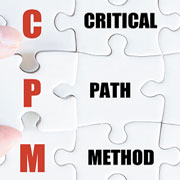Construction project financing and cash flow management are unique for several reasons.
First, start-up construction companies are very easy to form with the “two men, tools, and a truck” business model. Because of this, credit and business history often are not extensive as the positive histories that typically give businesses access to large sums of capital to start the business.
Second, cash flows on projects are such that trade contractors bear the financial burden. This is because they pay their crews on a weekly basis and pay their suppliers on thirty-day terms, but they receive money on a “pay when paid” structure. As a result, incoming cash typically lags far behind the outflows that were expended on a project.
One thing construction contractors can do to increase their proficiency at managing and financing cash flows is to examine the nature of the project. To do this they can use a modified critical path approach just as they would to execute their job site operational function.
 The critical path model for cash flow management means that
The critical path model for cash flow management means that
certain key financial goals must be met before a project can continue. For example, weekly payroll, major equipment financing down payments or cash payments to bind annual insurance policies cannot be missed or the next week there will be no workers, machinery deliveries and no certificates of insurance to allow
owners to get work authorizations.
These critical cash flow items are important not only because they are vital to proceeding with a project, but also because they are large, and therefore they must be planned for. So segregating existing cash reserves and allocating incoming cash flows in order to formally meet these upcoming financial necessities by using a chart like the one below will not only help you see clearly what needs to be done to meet those objectives, but also how much cash will be left over after these critical cash outflows are satisfied.
Two Week Cash Flow Projection
| Current Cash, Operating | $140,000 |
| Customer A Planned Income, 7 Days | $750,000 |
| $890,000 | |
| Expenditures | |
| Insurance Policy Binder, 5 Days | $60,000 |
| Equipment Down payment, 10 Days | $55,000 |
| Payroll, Week 1 | $110,000 |
| Payroll, Week 2 | $110,000 |
| Investment, 9 Days | $100,000 |
| Shareholder Distributions, 7 Days | $90,000 |
| $525,000 | |
| Cash For Other Uses, Two Weeks | $365,000 |
Cash Available For Use
A key distinction to make when using the critical path model for cash flow management is between cash that is available and that is not available for use. This sounds incredibly simplistic, but the idea can revolutionize the financial operations of a construction company that is struggling to keep up with its debts and bills. Put another way, the best way to meet financial targets and put financial muscle behind your company decisions is to set aside cash for those disbursements.
As current cash reserves and incoming cash flows are set aside, they are no longer available for use, even if they are in the bank. The cash that is available for use is at the bottom line of the chart above. That cash is all that is available to meet general sales and administrative expenses, unpredictable obligations and such other uses as savings, investments, and owner distributions.
The Advantages
Separating these non-negotiable, large cash outflows from more routine, smaller cash flows will help you see not only how to meet your bigger, critical financial obligations but also how to save money for expenditures you may have been unable to make in the past.
Check with your financial accounting and tax advisers on this and other ways to maximize your cash flows.
©2018


